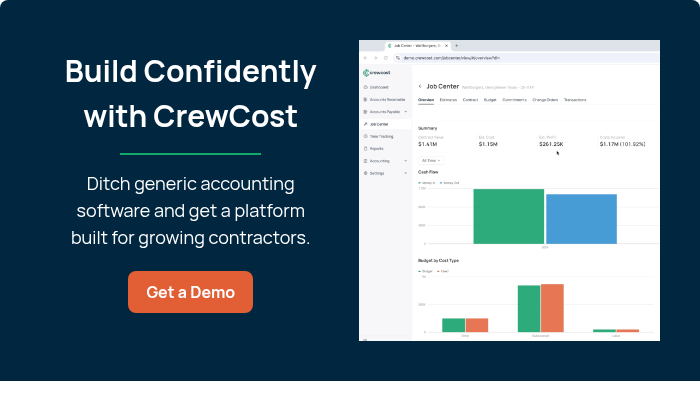How Budgets Help Contractors Grow
If you want to grow your business, you have to control what you’re spending and where. With a budget to reference, you can see where you’re overspending (or underspending) at any given moment.
In my own business, I do a budget vs. actual review every single month. This helps me not only see what I’m spending where, but gives me a chance to ask, “Why did we spend x amount in this category?” If there’s an overrun or an area where I see we’re leaking cash consistently, I can fix it proactively instead of being caught off-guard.
So what does a proactive budgeting process look like in construction? Start by reviewing your profit and loss statement at the end of each month. The way I approach this in my business and my clients’ businesses is by tying it in with forecasting. We do a 12-month cash flow forecast laying out our revenue, expenses, and cash flow over the upcoming year. This way, I can tell you exactly what the business plans to spend in any given month.
Once a month, take a look at your P&L and see how your actual spending lines up with what you planned to spend in your budget. As you’re reviewing, ask yourself these questions:
- Where did we go off plan?
- Where did we overspend? Was it strategic or something we need to fix?
- Where did we underspend? How can we correct that?
One thing I consistently tell my clients is that they’re in charge of their money, not the other way around. I have a lot of owners tell me they’d like to spend more on marketing their business but can’t afford it. In reality, it’s not that they can’t afford it - it’s that they haven’t allocated the money for it in a budget. You have to be the one to strategically decide where you want your money to go each month, and make adjustments to your spending accordingly. This is how you grow your profitability over time.
Annual vs. Rolling Budgets: Which One is Right For Your Business?
Another component of construction budgeting I think is important to touch on is the difference between annual and rolling budgets.
Annual budgets are the standard and are calculated based on the previous year’s data. Yearly budgets are fixed, and the goal is to stick as closely to them as possible.
Rolling budgets take a more flexible approach. This kind of budget is updated monthly and allows you to make strategic adjustments as the year goes on.
Personally, I don’t like the annual budget method alone because it’s unnecessarily restrictive. That’s why I take a hybrid approach in my own business. We set an annual budget at the beginning of the year, but we also review it every month and make adjustments as needed. The key here is to make sure the team understands that any changes to the budget directly impact the profitability plan established at the start of the year.
Here’s why it works for us: Imagine a great opportunity comes our way in Q3 that we never thought to budget for. Are we supposed to turn it down? I don’t think so. A rolling budget allows us to stay flexible when those opportunities come knocking.
Keep in mind though that rolling budgets without an annual plan can be dangerous because the budget quickly becomes pointless. If you’re changing it every month to fit how you’re feeling that day, you never really achieve anything. This is why I recommend setting an annual plan that you’re working to achieve, with the ability to adapt as you walk through the reality of the year.
How to Build a 12-Month Trended P&L
Even if you’re 100% new to budgeting, putting one together is easier than you’d think. Start with your accounting system, which should have the ability to run reports. Then, follow these steps:
- Have your system run a 12-month trended P&L. This is the same as an ordinary P&L but includes a column for every month over the past year.
- At the end of every month, run a new one of these trended reports. For example, if it’s the end of February 2025, run a report for February 2024-January 2025.
- Add this data to a spreadsheet and take a look at what you’ve spent by category. You’ll use this data to make a plan for the next twelve months.
- For certain categories like marketing, decide what’s most strategic for your business. Does it make more sense to spend a set amount each month, or should you plan for bursts of spending throughout the year? Ask yourself detailed questions like these to make sure your plan aligns with your overall business goals.
When this is done, you should have a budget tailored specifically to your business that aligns with where you want to go over the next year.
Wrapping Up
If you’ve never used a budget before, it can feel like a big shift. Trust me though, your future self will thank you. A healthy budget plan for your business shouldn’t restrict your spending. Instead, it should inform and focus that spending so you can set your money free to do the right things.
At Cruzumi, we’ll do the heavy lifting for you. Drop us a line and let us help you build a budget that works for your business, not against it.

